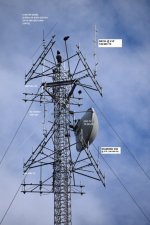The picture posted above is pretty crazy if anyone needs that antenna to work behind it. Wow.. So, spacing the antenna 1/4 wave off the surface generally results in 3-ish dB of gain in the direction of the antenna, as the mast becomes a reflector. Moving the antenna 1/2 wave off the mast usually results in a somewhat bi-directional pattern, but all of this depends on the size of the mast behind the radiator. Antenna patterns are pretty unpredictable, even with software modeling. I have access to TAP7, which is supposed to be one of the best commercially available tools.
The picture I've attached is what I'm working with concerning my area's primary 2-meter repeater. The DB224 out the top is what I've duplexed as a single antenna for years. It's a 150-160 antenna, and with 480 feet of 7/8" line I get about a 1.6:1 match in the building at the TX frequency. Yes, I know the match throws the duplexer curves off a little and I've compensated for that. I've tried a variety of duplexers and filters, from a 4-cavity Sinclair Q2220E to a hefty Wacom 6-cavity with 10" cavity diameters and 2.5 dB of loss. I've also tried running high (>100W), medium (50W) and low (25) power settings with various results. The repeater is either a Quantar 125W or a 40W MTR2000. Sometimes the top antenna duplexes fine, other times, any amount of power creates what appears to be broadband "illumination" noise. Depending on the time of day, humidity, weather conditions (especially dry air) I get up to 3 microvolts of receive noise (that's straight receive, NOT desense from the transmitter!). It's the highest thing on the tower and the highest thing is most always going to be the noisiest! I did some further searches on the subject, and I'm not alone in these findings! Check the link below. Good article:
Pecipitation Static or P-static
Scroll down to "Case 4 - repeater antennas"
If the wind is calm and the humidity is up, the noise floor is relatively low and I can duplex full power into the antenna with zero problems. But 75% of the time, this is not the case.
The Diamond X50 is my spare antenna. To answer the question above, it's mounted 6 feet away from the tower, but the tower face is 30 inches and there's a lot of metal up there. There is some shading through the tower, as to be expected, but it's not a deal-breaker to use it.
My initial thoughts were to receive on the top antenna and transmitting bunches of power on the side mounted X-50, attempting to gear my performance toward the receive side of things like commercial operators do (such as the 800 MHz antennas in the photo). While the amount of isolation between the two antennas is high enough to run the repeater without filtering, I tried this and it worked - but the general noise floor on RX was still very high most days. I dared to do something unthinkable - RECIEVE on the lower antenna, and TRANSMIT on the top. Guess what - the Diamond X50 had 10 to 15 dB LESS NOISE than the top antenna during adverse conditions. Although the feedline loss, antenna gain and the null in one direction are all disadvantages to using the X50 as my primary receive antenna, the reduced noise floor improvement offsets the other factors by quite a margin. I have been running this configuration for about a month and the change was certainly an improvement.
I am fairly convinced that on VHF frequencies and lower, the only antenna that needs to be out the top of the tower is a paging antenna where transmit is the primary concern. At UHF frequencies, I have never really seen degradation on RX by being out the top. But real-time experience has taught me that side mounting VHF arrays for receive are probably (likely) the best way to go for the lowest ambient noise on RX.





